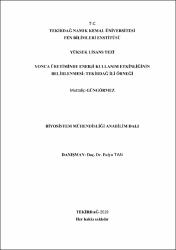| dc.contributor.author | Güngörmez, Muttalip | |
| dc.date.accessioned | 2020-01-31T11:10:32Z | |
| dc.date.available | 2020-01-31T11:10:32Z | |
| dc.date.issued | 2019 | |
| dc.identifier.uri | https://hdl.handle.net/20.500.11776/3527 | |
| dc.description.abstract | Bu çalışmada, Tekirdağ ilinde yonca üretiminde uygulanan farklı hasat sistemlerinde kullanılan enerji girdileri incelenmiştir. Yonca üretiminde kullanılan dolaylı ve doğrudan enerji girdileri, üreticilerle yapılan anket çalışmaları ile belirlenmiştir. Yonca hasadında altı farklı (H1, H2, H3, H4, H5 ve H6) kuru ot hasat sistemi ve silaj yapımında (H7, H8, H9, H10 ve H11) beş farklı hasat sistemi incelenmiştir. Çalışmanın temel amacı; yonca üretiminde kuru ot ve silaj yapımındaki harcanan temel enerji girdileri açısından analiz edebilmektir. Doğrudan enerji girdisi en yüksek kuru ot üretim sisteminde, dolaylı enerji girdisi ise en yüksek silaj üretim sisteminde hesaplanmıştır. Toplam enerji girdisi en yüksek balya silajı üretiminde 20787.19 MJ/ha, kuru ot üretim sisteminde ise silindirik balya kullanılan sistemde 19454.57 MJ/ha hesaplanmıştır. En yüksek enerji verimliliği (20.07), özgül enerji (2.26 MJ/kg) ve en düşük net enerji üretimi (396443.81 MJ/ha) ile balya silaj üretim sisteminde saptanmıştır. Enerji üretkenliği ise en yüksek 0.53 kg/MJ ile kuru ot (D) sisteminde ve yığın silaj üretim sistemlerinde hesaplanmıştır. | en_US |
| dc.description.abstract | In this study, the energy inputs of different harvesting systems applied in alfalfa production in Tekirdağ province were investigated. Indirect and direct energy inputs used in alfalfa production were determined by surveys conducted with producers. In the alfalfa harvest, six different harvesting systems (H1, H2, H3, H4, H5 and H6) and five different harvesting systems in silage making (H7, H8, H9, H10 and H11) were investigated. The main aim of the study is to analyze the basic energy inputs in the production of dry grass and silage in alfalfa production. Direct energy input is calculated in the highest dry grass production system, while indirect energy input is calculated in the highest silage production system. The highest total energy input was calculated in the production of bale silage (20787.19 MJ / ha) and in the dry grass production system (19454.57 MJ / ha). The highest energy efficiency (20.07%), the highest specific energy (2.26 MJ / kg) and the lowest net energy production (396443.81 MJ / ha) were determined in the bale silage production system. Energy efficiency was calculated with 0.53 kg / MJ in dry grass (D) system and pile-type silage production system. | en_US |
| dc.language.iso | tur | en_US |
| dc.publisher | Namık Kemal Üniversitesi | en_US |
| dc.rights | info:eu-repo/semantics/openAccess | en_US |
| dc.subject | Yonca | en_US |
| dc.subject | enerji girdileri | en_US |
| dc.subject | hasat sistemleri | en_US |
| dc.subject | enerji etkinliği | en_US |
| dc.subject | Alfalfa | en_US |
| dc.subject | energy input | en_US |
| dc.subject | harvest systems | en_US |
| dc.subject | energy efficiency | en_US |
| dc.title | Yonca üretiminde enerji kullanım etkinliğinin belirlenmesi: Tekirdağ ili örneği | en_US |
| dc.title.alternative | DETERMINATION OF ENERGY USE EFFICIENCY OF ALFALFA PRODUCTION: A CASE STUDY OF TEKIRDAG PROVINCE | en_US |
| dc.type | masterThesis | en_US |
| dc.department | Enstitüler, Fen Bilimleri Enstitüsü, Biyosistem Mühendisliği Ana Bilim Dalı | en_US |
| dc.relation.publicationcategory | Tez | en_US |



















